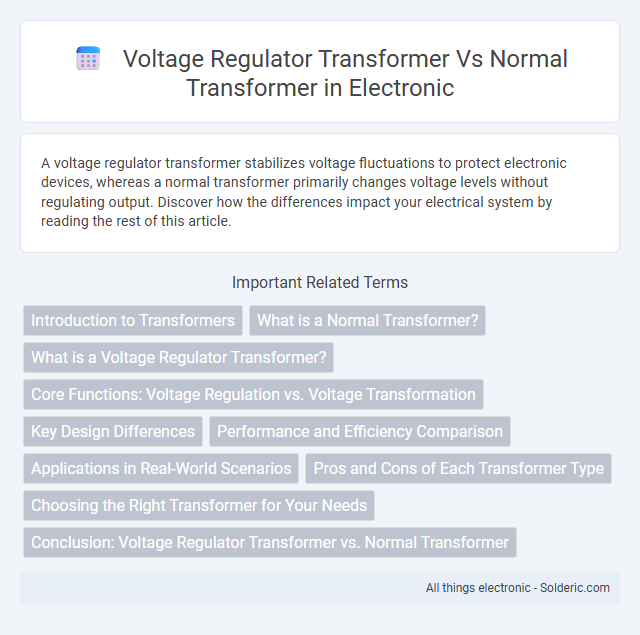A voltage regulator transformer stabilizes voltage fluctuations to protect electronic devices, whereas a normal transformer primarily changes voltage levels without regulating output. Discover how the differences impact your electrical system by reading the rest of this article.
Comparison Table
| Feature | Voltage Regulator Transformer (VRT) | Normal Transformer |
|---|---|---|
| Primary Function | Maintains stable output voltage despite input fluctuations | Changes voltage level without regulating output |
| Voltage Regulation | Automatic voltage correction within set range | No voltage regulation; fixed transformation ratio |
| Applications | Power supply stabilization for sensitive equipment | General voltage step-up or step-down in power systems |
| Complexity | More complex with additional components | Simple core and winding design |
| Cost | Higher due to regulation features | Lower, basic transformer design |
| Output Voltage | Stable and controlled | Varies with input voltage |
| Efficiency | Slightly lower due to regulation losses | Higher under steady load conditions |
| Maintenance | Requires regular inspection for regulation components | Low maintenance |
Introduction to Transformers
Transformers are electrical devices that transfer electrical energy between circuits through electromagnetic induction, primarily used to increase or decrease voltage levels. A voltage regulator transformer (VRT) differs from a normal transformer by automatically adjusting its output voltage to maintain a constant voltage level, even with fluctuating input voltage. Your electrical systems benefit from a VRT as it ensures stable voltage, protecting sensitive equipment from damage caused by voltage variations common with normal transformers.
What is a Normal Transformer?
A normal transformer is an electrical device that transfers electrical energy between two or more circuits through electromagnetic induction, primarily used to step up or step down voltage levels. It operates at a fixed voltage ratio without compensating for voltage fluctuations in the supply network. Unlike voltage regulator transformers designed for voltage stabilization, normal transformers do not actively maintain output voltage within a specific range under varying load conditions.
What is a Voltage Regulator Transformer?
A Voltage Regulator Transformer (VRT) continuously adjusts the output voltage to maintain a stable and consistent supply despite fluctuations in the input voltage, ensuring sensitive equipment receives optimal power. Unlike normal transformers, which only change voltage levels without regulation, the VRT automatically compensates for voltage variations to protect your devices from damage caused by overvoltage or undervoltage. This regulation capability makes voltage regulator transformers essential in applications requiring precise voltage control for enhanced reliability and performance.
Core Functions: Voltage Regulation vs. Voltage Transformation
Voltage regulator transformers maintain a consistent output voltage despite input voltage fluctuations, ensuring stable power supply for sensitive equipment. Normal transformers primarily convert voltage levels between high and low without correcting voltage variations. While normal transformers focus on voltage transformation, voltage regulator transformers actively stabilize voltage to protect electrical devices.
Key Design Differences
Voltage regulator transformers feature adjustable taps or automatic voltage control mechanisms to maintain a consistent output voltage despite input fluctuations, unlike normal transformers which provide a fixed voltage transformation ratio. The core design of voltage regulator transformers often incorporates specialized winding configurations and tap changers for precise voltage regulation. Your choice depends on whether stable voltage supply or simple voltage step-up/down is required.
Performance and Efficiency Comparison
Voltage regulator transformers maintain a stable output voltage despite input fluctuations, enhancing performance in sensitive electronic applications compared to normal transformers, which do not regulate voltage. Your power system efficiency improves with voltage regulator transformers by reducing energy losses caused by voltage variations, whereas normal transformers may allow significant voltage drops, affecting device operation. The ability of voltage regulator transformers to provide consistent voltage ensures higher reliability and extended equipment lifespan compared to standard transformers.
Applications in Real-World Scenarios
Voltage regulator transformers are essential in applications requiring consistent voltage output despite input fluctuations, such as in telecommunications, medical equipment, and industrial automation. Normal transformers primarily serve to step up or step down voltage without regulating fluctuations, making them ideal for basic power distribution in residential and commercial buildings. Your choice between the two depends on the need for voltage stability versus simple voltage conversion in real-world scenarios.
Pros and Cons of Each Transformer Type
Voltage regulator transformers provide precise voltage control, enhancing equipment protection and reducing power fluctuations, but they typically have higher initial costs and increased maintenance requirements compared to normal transformers. Normal transformers offer cost-effectiveness and simplicity for voltage step-up or step-down applications but lack the ability to stabilize voltage under varying load conditions, potentially leading to equipment damage or inefficiency. Choosing between these transformers depends on the need for voltage regulation versus basic voltage transformation, balancing performance demands with budget constraints.
Choosing the Right Transformer for Your Needs
Voltage regulator transformers maintain stable output voltage despite input fluctuations, making them essential for sensitive electronic equipment and industrial applications requiring precise voltage control. Normal transformers simply step up or step down voltage without handling voltage variations, suitable for general power distribution where input voltage remains stable. Selecting the right transformer depends on the application's voltage stability requirements and the criticality of consistent power quality.
Conclusion: Voltage Regulator Transformer vs. Normal Transformer
Voltage regulator transformers maintain a constant output voltage despite input voltage fluctuations, ensuring stable power supply for sensitive equipment. Normal transformers primarily change voltage levels without regulating output voltage, making them less suitable for devices requiring consistent voltage. Your choice depends on the criticality of voltage stability in your electrical system.
voltage regulator transformer vs normal transformer Infographic

 solderic.com
solderic.com